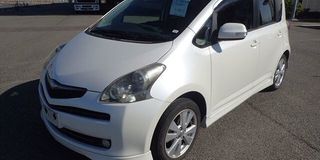Toyota Ractis: The new queen of the road

What you need to know:
A bit boxy by shape and a subcompact vehicle by make, with front and rear edges almost similar to those of the Spacio, the Toyota Ractis comes edges over the Spacio in terms of interior spaciousness and driving comfort
One of the reasons why Toyota vehicles are admired especially in Uganda, is their user friendliness. This could range from aspects such as fuel consumption and the ease of service and maintenance among some of its brands such as Toyota Spacio, Premio, Vitz, IST, and Corolla, popularly known as Kikumi and Toyota Corona among others.
What you can call the latest addition to this list is the Toyota Ractis. A bit boxy by shape and a subcompact vehicle by make, with front and rear edges almost similar to those of the Spacio, the Toyota Ractis comes edges over the Spacio in terms of interior spaciousness and driving comfort. In fact, you can easily mistake it for a Spacio when you approach it from the front.
As far as engine power and performance is concerned, the Ractis gives you two engine options to choose from; you can either go for one that runs on a 1300cc engine size or one that runs on a 1500cc engine and gives you more engine power.
Joseph Kabonge, who acquired a Ractis five months ago says it was hard for him to make a choice between the 1300cc and 1500cc run Ractis engines because they both suited the sole purpose for which he needed the car- fuel efficiency.
Kabonge, an Uber driver, also wanted a car that could comfortably accommodate his family, before zeroing down on the 1500cc engine Ractis.
“I wanted a car that could cover a longer distance without consuming a lot of fuel,” Kabonge explains.
In traffic jam, Kabonge says the Ractis has capability of giving you between seven to 10 kilometres using one litre of fuel and approximately 15kilometres or more using one litre on a highway.
“Everything on the car is perfect but one of the downsides is that it seems to have been built for urban roads. It has a low ground clearance and you will easily rub against the road surface when you are driving on murram roads,” Kabonge explains.
Fortunately, according to Kabonge, what can save you from potholes or when rain catches you on a slippery road is that the Ractis runs on a four wheel drive (4WD) system, with an option of disengaging where you do not need it.
Cost of maintenance
Edwin Jjuuko, a mechanic says a Toyota Ractis is not one you will park home because you have failed to get a particular spare part. Once you experience any mechanical problem, you can easily drive into any garage and drive to your destination comfortably.
“Unless it is a complex mechanical problem such as an engine knock, you will be charged approximately Shs150,000 to carry out service and maintenance once in three months. If it is your type of daily car, minor service will stretch a little to Shs200,000,” Jjuuko explains.
The Ractis, Jjuuko adds, shares some parts with its predecessor, the Toyota Yaris and other Toyota brands such as the Spacio, Allex and a few other others.
Alex Kabogoza, a car dealer advises that if one is looking for fuel efficiency, the 1300cc engine size Ractis is one to go for because of the high mileage it gives you on and off-road. Then also, the fact that it comes in either automatic or manual transmission formats and in two wheel (2WD) drive and 4WD where you choose what mode you want, is the other reason to go for a less-fuel consuming car.
According to sbtjapan, an online portal, the car was introduced in the year 2005 as the successor of Toyota Yaris Verso. The name Toyota Ractis is derived from three basic words which are run, activity and space.
The portal adds that the Ractis has offered a lot of space and features and has made huge markets all over the world. The first generation was sold in the market from 2005 to 2010 and the production of second generation started in 2010 and is currently sold in the market.
Passenger capacity
Besides the 4WD system, the Ractis equally commands huge interior space portions. Like the Toyota Nadia and Ipsum, you can also adjust or tilt the rear passenger seats to create space for additional luggage in the trunk courtesy of its roof that is higher than that of, for example a Spacio. Like most cars of its category, the Ractis is a five-passenger carrier that can comfortably accommodate six average sized passengers. It also comes with enough legroom for the driver and co-driver and passengers.




